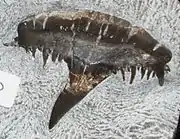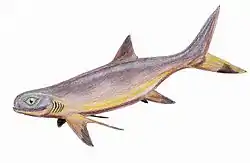Symmorium
Symmorium is a dubious genus of extinct stethacanthid holocephalian from the Devonian and Carboniferous of the United States (Illinois)[1][2] and Russia.[3] The type species, Symmorium reniforme, was named by Edward Drinker Cope in 1893[4] and several other species were originally classed under this genus, but they have since been classified into other genera such as Petalodus. Symmorium bears close similarity in size and appearance to Stethacanthus[5] but the former is missing the "spine and brush" on its back.[6] Some paleontologists think that the two forms are simply the males and females of related species, while other scientists think they were distinct genera.[6][7]
 Preserved S. reniforme specimen
Preserved S. reniforme specimen Tooth from an unnamed Symmorium species
Tooth from an unnamed Symmorium species
| Symmorium | |
|---|---|
 | |
| Scientific classification | |
| Kingdom: | Animalia |
| Phylum: | Chordata |
| Class: | Chondrichthyes |
| Order: | †Symmoriida |
| Family: | †Symmoriidae |
| Genus: | †Symmorium Cope, 1893 |
| Species: | †S. reniforme |
| Binomial name | |
| †Symmorium reniforme Cope, 1893 | |
References
- E. D. Cope. 1894. New and little known Paleozoic and Mesozoic fishes. Journal of the Academy of Natural Sciences Philadelphia (Series 2) 9:427-448 [M. Clapham/M. Clapham]
- M. E. Williams. 1985. The "Cladodont level" sharks of the Pennsylvanian black shales of central North America. Palaeontographica Abteilung A 190:83-158 [M. Clapham/P. Vazquez]
- A. Ivanov. 1999. Late Devonian - Early Permian chondrichthyans of the Russian Arctic. Acta Palaeontologica Polonica 49(3):267-285 [M. Clapham/P. Vazquez]
- E. D. Cope. 1893. On Symmorium, and the position of cladodont sharks. American Naturalist 27:999-1001
- https://web.archive.org/web/20070927011823/http://comenius.susqu.edu/biol/202/Animals/DEUTEROSTOMES/CRANIATA/CHONDRICHTHYES.htm
- M. Ginter, O. Hampe, and C. J. Duffin. 2010. Chondrichthyes, Paleozoic Elasmobranchii: Teeth. In H.P. Schultze (ed.), Handbook of Paleoichthyology 3D:1-168 [M. Clapham/P. Vazquez]
- Coates, Michael I.; Gess, Robert W.; Finarelli, John A.; Criswell, Katharine E.; Tietjen, Kristen (2017). "A symmoriiform chondrichthyan braincase and the origin of chimaeroid fishes". Nature. 541 (7636): 208–211. Bibcode:2017Natur.541..208C. doi:10.1038/nature20806. ISSN 0028-0836. PMID 28052054. S2CID 4455946.
This article is issued from Wikipedia. The text is licensed under Creative Commons - Attribution - Sharealike. Additional terms may apply for the media files.